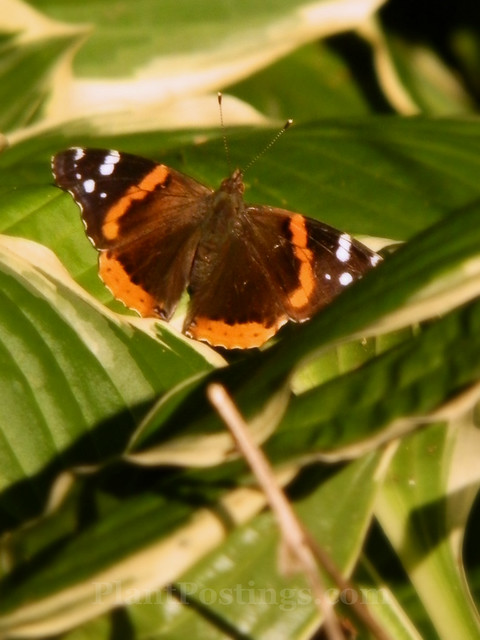 |
| Vanessa atalanta |
It's Garden Bloggers' Bloom Day, celebrated on the 15th of each month, and I'm sneaking in just under the wire with my contribution. If you have a chance, check out Carol's wonderful meme, over at May Dreams Gardens.
Before I start with the blooms: Here's a pollinator update.
We've already had some action with butterflies this season--Mourning Cloaks, Tiger Swallowtails, and many Red Admirals, like the one resting among the hostas in the first photo. I'm a little concerned about the bumblebees, as their numbers seem smaller, despite the fact that many plants are blooming.
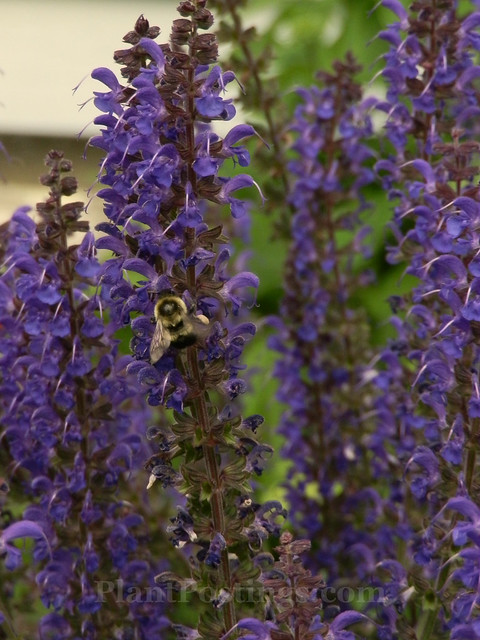 |
| Carpenter Bee on Salvia 'May Night' |
The Carpenter Bees are very active, though, on the Salvia, and I have noticed a few honey bees there, too. Traditionally, this plant is one of the more popular pollinator hangouts in my garden. After the blooms fade, I clip them repeatedly throughout the summer for several rounds of continued flowering.
Among other perennials and blooming shrubs that are currently (or were recently) stars in the garden:
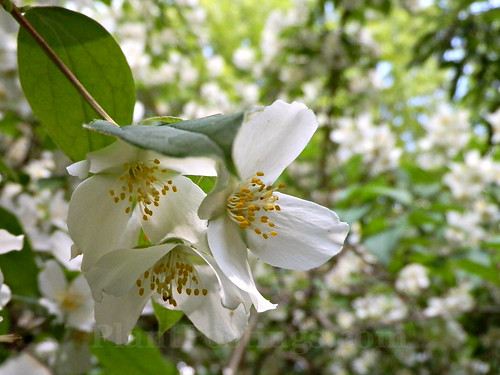 |
| Philadelphus spp. |
The Mock Oranges have been gorgeous this year. I'm unsure exactly which species we have, since the shrubs were here when we moved in. They always give us a great show in late spring, along with a pleasant, understated scent.
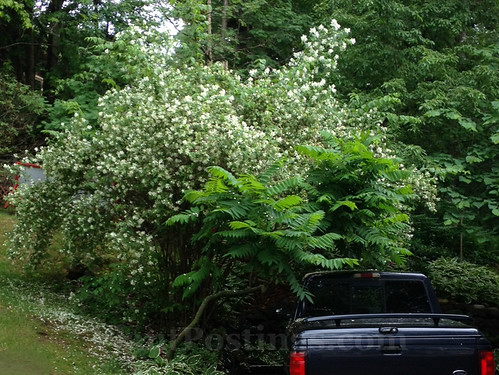 |
| I wasn't planning to include this photo with the truck, but it illustrates the scale and lovely draping pattern of the Mock Oranges (with leaning Staghorn Sumac in front). |
 |
| Aquilegia canadensis |
Columbines are still blooming in several spots where I added them last year. They seem to thrive in sun, part sun, and even deep shade. (The fuzzy stuff you see on the blooms is Cottonwood fluff from several neighborhood trees, which have been especially prolific with their seeds this year.)
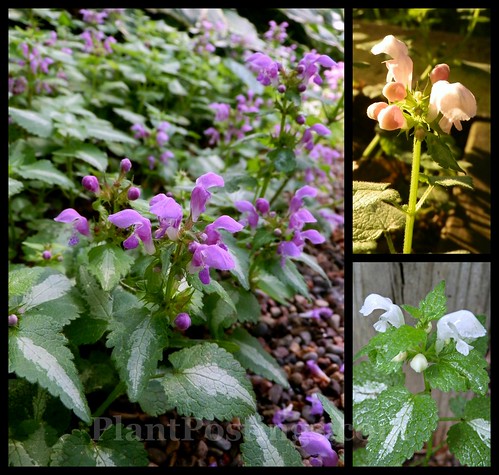 |
| Lamium maculatum |
Dead Nettles of various colors seem to bloom all season long. I suppose they could be invasive, but here they only seem to spread under the picnic table and in an enclosed area along a gravel path.
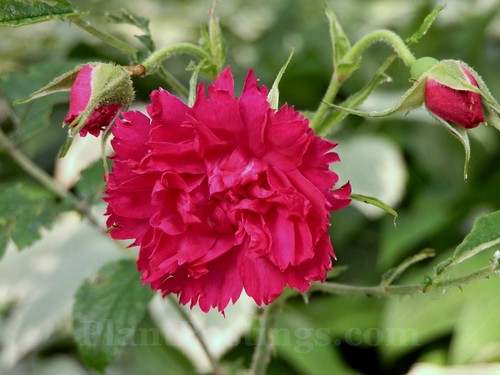 |
| Unknown rose hybrid |
Some of our roses are blooming.
And many of the annuals I added in May are flowering prolifically, including:
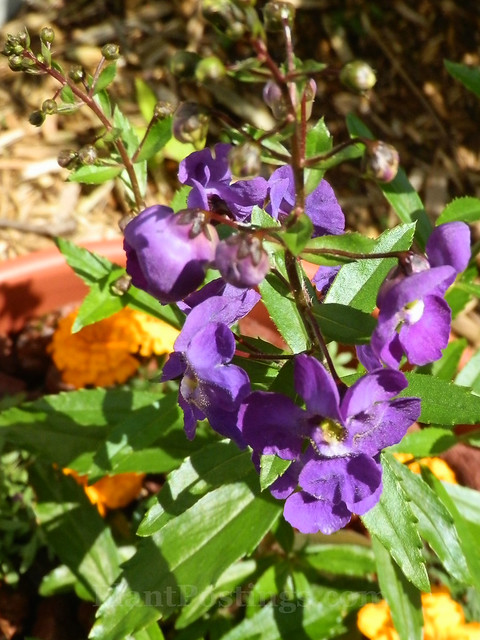 |
| Angelonia angustifolia |
Angelonia, which I potted with Marigolds. I think the hummingbirds like these, although I haven't seen them here yet.
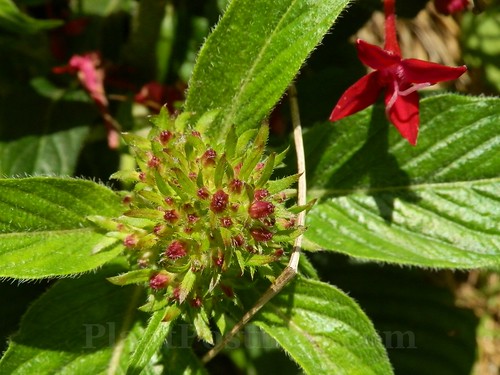 |
| Pentas lanceolata 'Graffiti Red Lace' |
Red Pentas, which I planted for the butterflies and bees (and potentially for cut flowers). They're on their second round of blooms. This is my first time planting Pentas.
 |
| Top: 'Aretes Upright Arroyo Grande' Bottom: 'Windchimes' |
I always plant Fuchsias for the hummingbirds. Who can resist these flowers?
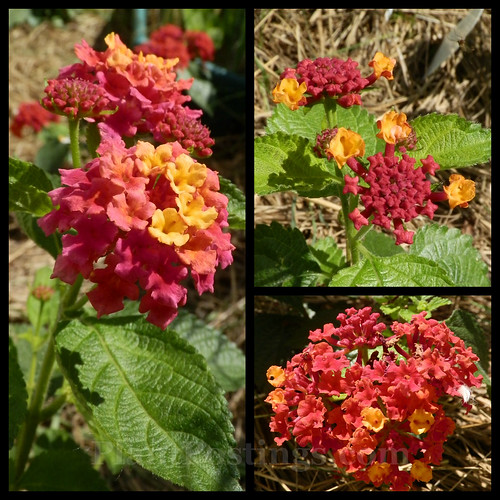 |
| Left: 'Blaze' Right top and bottom: 'Bandana Red' |
The Lantanas are settling in to their sunny spots in the potager. I hope they'll attract butterflies like they did last year.
 |
| Polygonatum biflorum |
Solomon's Seal's flowers remind me of petticoats.
In addition, many plants are on the verge of blooming, and I find their buds such a promising stage in the garden:
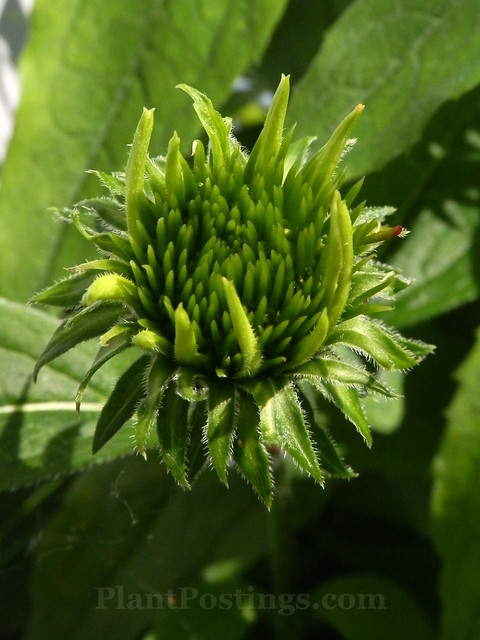 |
| Echinacea purpurea |
Native Purple Coneflower, a workhorse in the potager and great for cut flower arrangements;
 |
| Asclepias tuberosa |
Butterfly Weed, planted for its beauty, and as a larval host and nectar source for Monarch butterflies;
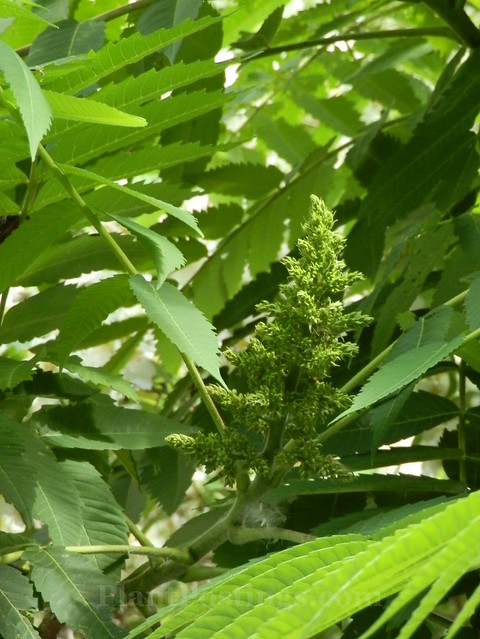 |
| Rhus typhina |
The Staghorn Sumacs, whose blooms will yield bright, warm red berries in the fall and winter;
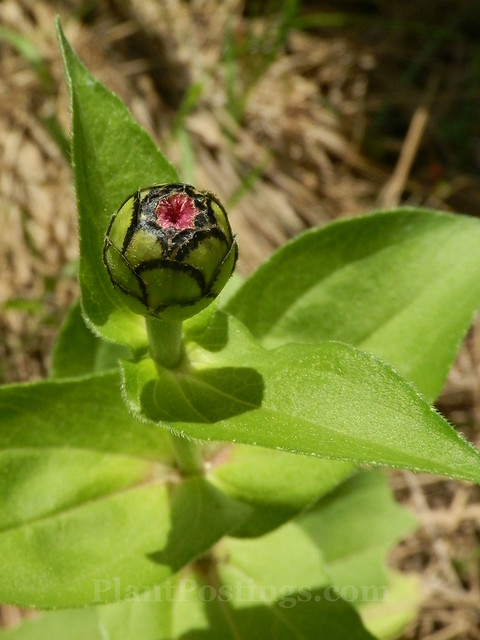 |
| Zinnia 'Cut and Come Again' |
Zinnias, which I also grow for cut flowers (since I couldn't find my favorite, 'State Fair Mix' at the garden center, I chose 'Cut and Come Again' this year);
 |
| Actea racemosa (syn. Cimicifuga racemosa) |
And, finally, the elegant Bugbane, which always seems to bloom near the solstice, with tall, white, elegant spikes.
* * * * * * * * * * * * * * * * * *
There's still time to participate in the "Garden Lessons Learned" meme. Feel free to write a post or share one you've already written about your "Lessons Learned" during the past season. Then share your links or simple observations in the comments at: Garden Lessons Learned, Quarter 2, 2015. The link will be available always under the "Lessons Learned" tab at the top of this blog.
Please also join in Donna's Seasonal Celebrations at Gardens Eye View! You can join in with a post that fits both memes, or separate posts for one or both of them. I'll include wrap-ups on PlantPostings' Facebook page as we approach the solstice.
Please also join in Donna's Seasonal Celebrations at Gardens Eye View! You can join in with a post that fits both memes, or separate posts for one or both of them. I'll include wrap-ups on PlantPostings' Facebook page as we approach the solstice.

I was admiring your lovely blooms till I came to lantana. I was stricken as I thought, "I forgot about lantana!" I meant to plant some much earlier, but somehow I had other plants to buy, other chores to do. But I realize I have the perfect place for lantana and must get some and plant it, despite our mid-90s temps this week. Thanks for the reminder!
ReplyDeleteHa! Yes, we can't forget the Lantana...at least where it isn't invasive, like my garden (and yours?). I think it's only invasive in Florida and some other tropical regions of the world. Here, it's a perfect annual!
DeleteWhat lovely blooms and amazing photos. I have never seen a rose anything like that before, the flower is such an unusual shape, it' s gorgeous.
ReplyDeleteThanks, Chloris. Regarding the rose, I've hunted and researched, and I can't seem to positively ID it. It was here when we moved in. I like the shape and it grows well in shade, but it gets infested with thrips fast! After it blooms, I cut it way back and it blooms again in late summer.
DeleteWe have had quite a few butterflies here too. They designated Pollinator week correctly, as they have been plentiful. My butterflyweed is at the same bloom stage. Almost ready to pop. I like the mock orange, the fragrance must be wonderful when you walk to the truck.
ReplyDeleteYes, good timing with pollinator week. :) I'm looking forward to the Butterfly Weed blooming. The patch gets larger every year, and it looks like it will put on quite a show this year. The Mock Orange has a very light scent, but yes it's very pleasant.
DeleteMy oh my, such a wealth of flowering beauty you provide . . .
ReplyDeleteThe butterflies, hummingbirds will be in Plant Posting heaven . . .
Beautiful Beth . . .
(Thank you for visiting me at my Irish Garden House and for your nice Rose petal comment.)
Hi Lynne: I hope the pollinators are happy. :) The hummingbirds seem to be sticking around, so that's a good sign. Maybe with a little warmer weather we'll see an increase in bees. I saw more honeybees on the plants today, which made me smile.
DeleteBeautiful photos! You have so much blooming--your garden is stunning. I admire that mock orange--wow! I'm trying to figure out where to put the Texas version in, but I'm not sure I have room. You'll enjoy your pentas--they're one of those plants that I categorize as "cheap thrill" plants--bloom, bloom, bloom and you can cut them or whatever! Thanks for the tour!
ReplyDeleteThanks! The Mock Orange shrubs were so pretty this year. That clump is really a grouping of two or three--kind of like a tall hedge. Mock Orange is one of my favorites, for sure. Thanks for the encouragement with the Pentas! I'm not sure why it took me so long to add them.
DeleteLovely flowers and photos, we are really low on Butterflies this year, but I have been planting the garden with bees in mind and it is starting to pay of...
ReplyDeleteAmanda xx
Thanks, Amanda. Usually, there are many more bumblebees this time of year. Maybe they're just waiting for the coneflowers to bloom. It's wonderful to watch all the pollinators, isn't it?
DeleteBeautiful! I really interested to your hybrid rose, unusual petal. So fascinating!
ReplyDeleteThank you, Endah. Yes, I can't seem to pin down the origins of the rose. Actually, it's a grouping of several around one of our trees. The plants were unmarked and here when we moved in. I like them, but they're very susceptible to pests. Since I use organic methods, I simply cut them back after they bloom, and then they bloom again in late summer.
DeleteYour Lantanas look so much healthier than mine! Also LOVE the photo of the carpenter bee on the salvia. My ceonothus are full of them. I really should post my pictures....but it is taking so much to get the book online! Now, it's ready. Beautiful photos Beth, thanks so much for sharing all, you are terrific.
ReplyDeleteHi Susie: I cheated with the Lantanas and bought small plants, but they do seem to be filling in nicely. The bees were a little more active on the flowers today, probably because we're warming up. And more plants are blooming in the potager, which should attract more. I want to see your photos, too! Continued good luck with your book!
DeleteI recognize so many of these from my perennial borders. I especially love the lantana, which is a new to me plant (it's probably quite common and I'm just showing how little I know about ornamentals now!)
ReplyDeleteI really enjoy posts like this as it reminds me to be more observant. I'm always so busy in the garden (I have yet to be caught up this year!), that I often forget to sit back and just enjoy.
Hi Margaret: I discovered Lantanas several years ago during a trip to New Orleans. The butterflies (particularly Monarchs and Swallowtails) love Lantanas! Yes, I need to be reminded about being observant, too. Once I get past the rush of the spring planting, it gets a little easier. But I do have plenty of garden maintenance that I need to tackle!
DeleteSo far we have seen Mourning Cloaks, Commas, and Red Admirals. Hoping for more. Bees seem rather scarce around here as well. We have many of the same plants, including the Asclepias, Zinnia 'Cut and Come Again' (mine is being chewed by rabbits), and Actaea racemosa.
ReplyDeleteI wonder what's up with the bumbles? Maybe the weird weather is to blame. With sun and warmth, I hope they'll increase in numbers. I haven't seen any Monarchs yet, although folks all around here have seen them. Maybe I need to spend some time at Olbrich. My Zinnias are walled into the potager with protective chicken wire. Rabbits are NOT welcome there. ;-)
DeleteEverything looks lovely as usual, Beth.
ReplyDeleteAre you sure that's not a bumblebee on the sage rather than a carpenter bee? I have a hard time distinguishing them, but I think/thought the carpenter bees were bigger and shinier than the one in your photo.
Does your staghorn sucker a lot? (I'm so glad you included the truck in that photo for showing the scale of the plants!)
Aquilegia has become a rock star in my garden and spreads *prolifically*. I'm happy to let it reseed, especially the native species (Aquilegia canadensis).
Feeling jealous about the deadnettle. I tried growing it here back in 2012 and it croaked. Still, that was an *awfully* hot and dry summer (even for us, record territory). Perhaps I should try again?
I tried pentas year, but the rabbits not only ate them, they actually uprooted them!! :O
I'm growing Lantana this year ('Miss Huff') for the 1st time. It seems to be settling in nicely, but haven't seen any butterflies (or any other pollinators) on either of my Lantanas yet...
Then again, my situation seems to be the opposite of yours - lots of bees, barely any buttterflies so far.
Hey Aaron: Interesting that our pollinator situations are flipped. It could be because we've had heat, followed by cold, followed by heat, followed by cloudy rain, repeat ad nauseum. Regarding the bee: I'm not an expert, but using this link as a guide: Eastern Carpenter Bee, the ones I've seen on the Salvia recently seem to resemble Carpenter Bees. It's hard to tell from the photo, but the abdomen is black and both the head and the abdomen are tucked under toward the plant. They are big bees, and I've had Carpenter Bees in that part of the garden before. But, you could be right! Hard to tell from this photo.
DeleteThe Staghorn is in a funny spot on the side of a hill (as are the Mock Oranges). We've thought about removing it, but so far, I've been able to prune it to keep it in check. In this particular spot, it doesn't sucker much. Love the Columbines! Total winners! The Deadnettle performs well here, but my climate is probably just a tad cooler than yours (although it made it through the 100s/drought of 2012). Maybe try it in deep shade? My Pentas are in the potager surrounded by chicken wire: Rabbits stay away! ;-)
Cheers!
I'm still at the careful baby steps stage of frantically adding plants for our pollinators. We found a tired bee and gave her some sugar water. And I think guiltily - I am trying to give you flowers!
ReplyDeleteSugar water is a good idea. Sometimes I put out a shallow dish that captures rain water. The only problem with that here where I live is that it can be a mosquito-breeding endeavor. Ugh. Hopefully, both of us will have happy pollinators. :)
DeleteWe have some of the same plants which means I made some good choices not being a gardener... Michelle
ReplyDeleteBut, Michelle, you are a gardener. You are a wildlife supporter. I'm glad we have some of the same plants so we can compare notes. :)
DeleteLoved your photo of the truck for scale. I just planted a dwarf version of this plant, thank goodness!
ReplyDeleteThanks--I snapped it with my smartphone on the way home the other day. The Mock Oranges were even lovelier earlier in the week. They greeted me with their beauty when I got home from my trip. A dwarf version is a good idea. Ours were here, though, when we moved in. I rather like their large size in this particular spot because they serve as a nice privacy screen. In a smaller area, however, a smaller hybrid would make more sense.
DeleteYou have so many interesting plants. Hope you have lots of butterflies this year--you're giving them plenty of enticement. Your lantana is blooming earlier than mine, but today I noticed a tiny bit of color on it.
ReplyDeleteThanks! It's always a joy to witness the grace of a butterfly. Every encounter is a moment of magic. I hope your Lantanas will bloom prolifically this summer!
DeleteYour photos are absolutely stunning!
ReplyDeleteThank you, Linda. It's a fun hobby. The plants are so beautiful and inspiring!
DeleteI think it's great to leave the truck in the shot - it shows exactly how large that bush is! I'll be out in the garden this afternoon looking for pollinators. I really like your bud pictures Beth - reminds me that I've got lots of photos of plants in their glory, but not many before they bloom. Going to take my coffee and camera outside and see what I can find!
ReplyDeleteHi Barbara: Sometimes I think the buds and the early blooms are the loveliest and most fascinating stages. They show so much promise before the plants shout and then their blooms fade. Some buds are exquisite, aren't they?
DeleteBeautiful photos.
ReplyDeleteWe also have been on the look out for pollinators. :-) We have some true bumblebees around this year, we are so happy to see them.
Carla
I'm seeing more bumbles and butterflies now that my Coneflowers are blooming. They're a delight to observe! Happy Pollinator Week!
DeleteJust beautiful. Your mock oranges are amazing. I did not know they got so big.
ReplyDeleteThank you! These Mock Oranges are established shrubs that have been in that spot for at least two decades. They make decent cut flowers, too. I can see I need to prune some of the top and sides. ;-)
DeleteStopping by from Jen's blog...nice to meet you. Such a beautiful variety of flowers. I especially love Mock Orange. The fragrance is so wonderful.
ReplyDeleteHi Mildred: Thanks for stopping by! I love Mock Oranges and I imagine they would be gorgeous trailing from a wedding bouquet. The species we have is not highly scented, but does have a pleasant scent on close observation.
DeleteHa, ha, I like the photo of the truck:) I always get frustrated when I download photos and discover one of our cars in the background that can't be cropped out of the photo. But you're right--it shows just how big the mock orange is, what a beautiful shrub! I see we have many planted many of the same annuals; angelonia, lantana, zinnias, and pentas are all favorites of mine, and the butterflies do love them. I haven't seen a lot of butterflies yet this year, other than Red Admirals, but I'm hoping that will change once the coneflowers all start to bloom.
ReplyDeleteYes, it's real life. ;-) I was walking back from the mailbox and thought I'd snap a photo with my smartphone before the blooms all faded. Then I thought: Why not include it with the post for scale? Glad you liked it. Rose, I looked for Zowie Zinnias and couldn't find them. Maybe next year! They're so gorgeous. And, yes, the bees and butterflies are increasing as the coneflowers unfurl. :)
DeleteAll of your images are gorgeous but lately probably because of our heat, I'm drawn to the green! Gorgeous.
ReplyDeleteJen
Thank you, Jen. And thanks for the link back--that was so kind. It is quite green around here, that's for sure!
DeleteEnjoyed viewing your photos as always -- love your fuchsias. I was helping out in a friend's garden last weekend and saw plenty of bee action. I occasionally had to abandon the patch I was weeding and return to it later so as not to disturb the bees.
ReplyDeleteHi Heather: Thanks! Yes, aren't the Fuchsias lovely. The first batch I bought took some time flowering so I bought more--for the hummingbirds. ;-) But now I see buds on the originals, too. Yay! The bumbles and butterflies are increasing now, so I'm happy.
DeleteYour blooms are diverse and lovely. I have lots of bee activity in my own garden, but have seen very few butterflies.
ReplyDeleteHi Les: Interesting how the activity of the pollinators ebbs and flows. It seems our awareness of their importance, generally, is increasing. May many butterflies be in your future. ;-)
DeleteI really enjoy your blog. I had a red admiral in the house this afternoon and a kitten crashing around trying to catch it. Happily, I got it before she did and put it back outside. I will have to try lantanas and pentas again. For whatever reason, they don't do well for me, but they are so beautiful. Hardly see any bees here either but have had several butterflies including one monarch on the red clover.
ReplyDeleteThanks! Yikes, a butterfly loose in the house! That's never happened to me, thankfully. Glad you were able to get yours free! It's too early for me to assess Pentas in my garden, but they seem to prefer the very hot, sunny days. The Lantanas are very happy here in the summer. Yay! Enjoy the pollinators!
DeleteDear Beth, nice to see what is blooming in your neck of the woods. That photo of the mock orange is stunning. What a size of a bush! I have to research if I can grow a mock orange in my own garden.
ReplyDeleteI also really like the salvia 'May Night', such an intensive dark purple color. This plant is on my wish list for quite a while now, maybe this year...
I am not familiar with Polygonatum biflorum, but love the bell shape blooms.
Looks like you are in for more bloom treats in the next couple of weeks!
Warm regards,
Christina
Hi Christina: The Mock Orange is finished blooming now, but some of the others (Coneflowers, Butterfly Weed) are hitting their stride. Happy summer!
DeleteI've had a lot of bees this year and several butterflies but the bees were slow to show up. That mock orange is incredible! So huge! Love your macros. They really show the artistry of each flower. :o)
ReplyDeleteHere's one of the biggest lessons I learned when I began gardening: not every rock is a boulder. Sometimes it's just a pebble. Dig it up, deal with it, and get on with life.
DeleteThanks, Tammy. I love this lesson! I need to keep reminding myself about this. I'm noticing more bumblebees and honey bees now that the Coneflowers and Buttefly Weed are blooming. I'm still concerned the numbers are down from last year. Time will tell...
DeleteHi Beth, You have so many wonderful flowers! I have never seen Dead Nettle with orange flowers before. Very beautiful! Your growing season seems to be almost in line with ours.....many that you have budding we have also. It's so much fun to see what's happening in gardens around the world. Happy gardening!
ReplyDeleteHappy gardening to you, too! The Lamiums that look orange, are actually pink, with the late afternoon oblique light making them look artificially peachy. Enjoy your summer!
Deletewonderful photos, Beth.
ReplyDeleteThank you, Sue! For some reason, I've missed some of your recen posts. I'll check my feed. I loved your most recent post!
DeleteBeth I adore visiting your garden with the variety of flowers all so happily blooming with loads of pollinators...I have seen the same butterflies but only 1 or 2 flitting through as the rain here has pushed them north...but the bees are plentiful and I have to share blooms with them or they get a bit testy....butterfly weed is blooming everywhere with common milkweed making all the pollinators sing.
ReplyDeleteI love your blog so much! My eyes are full of flowers and in summer, so hot this summer, are so much needed that I thank you for posting your GBBD!!!
ReplyDelete